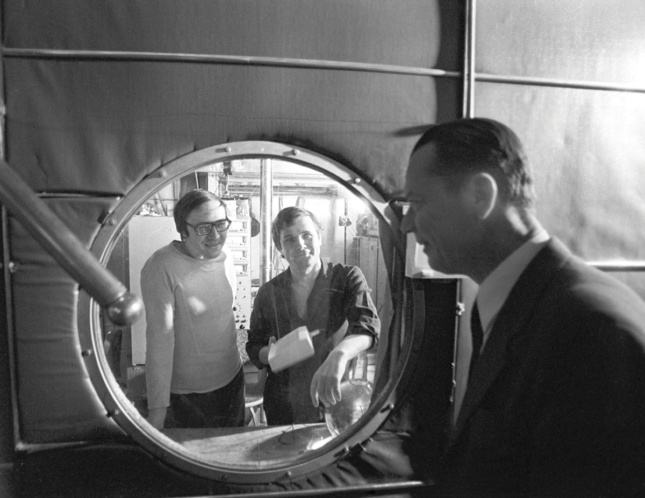The Architecture of Closed Worlds; or, What Is the Power of Shit?
Lydia Kallipoliti
Lars Muller Publishers
$40.00
Where’s the future we were promised? It’s hard to follow popular culture in the early 21st century without encountering variations on this question. Almost everybody remembers The Jetsons. This show is usually the go-to example for those who still—for some reason—want a jetpack (or, perhaps even less realistically, George Jetson’s three-hour work week). Saturday morning cartoons may have showed us the shiny future in our living rooms, but the futures of the 20th century were designed in the workshops, laboratories, and drafting studios of architects and designers, and most of that never made it to television. Lydia Kallipoliti’s new book, The Architecture of Closed Worlds; or, What Is the Power of Shit?, tells us, as the subtitle suggests, a messier set of stories about the hidden production history of design futures.
If commuters dream of a Utopia with flying cars, then urbanists, engineers, architects, and building scientists yearn for structures that clean themselves, eat their own waste, recycle their own water, and never need to tap an electrical grid. These are the “closed worlds” of the book’s title. This book is a catalogue of attempts, over an 80-year time span, to create self-sustaining structures that can support human life. But Kallipoliti shows that, besides acting on mere biology and its technical problems, the image of the closed world is a cultural agent as well. This is a dream that’s about more than survival; it’s about independence and the freedom to explore and expand life into hostile or unknown territories. The closed worlds here bridge the space between mainstream architectural history, science fiction, space science, pure engineering experiment, and countercultural autonomy. There are spaceships and communes, quack medicine and fad diets. There are brave explorers risking their own lives (Jacques Cousteau’s team living on the continental shelf), snarky art projects as cultural commentary (Ant Farm’s “clean air” inflatables), astronaut trainees getting sick on their own waste (in a 1960 simulation at NASA Langley), utopian technocrats (Masdar City), and even hamsters (SEEK). Of course, Bucky Fuller makes several appearances.

The book is organized like one of the classic “catalogues” of 20th century future studies. American audiences will recognize antecedents like Paula Taylor’s The Kids’ Whole Future Catalogue, from 1982, a riff on Stewart Brand’s 1968 Whole Earth Catalog, which featured underwater living, space settlements, and driverless cars. Another precedent, from the U.K., is the Usborne Book of the Future series, which presented domed cities, space elevators, and two-way wireless video chat via wristwatch. Like these books, Kallipoliti’s gives us a format that’s easy to browse casually at a surface level, and it’s just as easy to get lost in its depths. Also like these other collections, this book is lavishly illustrated. The period photographs and drawings are complemented and unified by a series of complex and compelling diagrams by Temitope Olujobi, showing the technical networks that these structures weave in order to create and sustain their environmental conditions.
But Closed Worlds is not a work of optimistic retrofuturism. Kallipoliti includes, along with each project entry, a section on “Key Failures.” Waste builds up, maintenance takes time, seals leak, crops fail—but even more broadly, hubris exists. The reach of these would-be world-makers often exceeds their grasp. These failures bring the projects back down to Earth, and Kallipoliti has invited a collection of practitioners and critics to join her in short essays that examine what it all means. These “Commentary” entries for select projects help contextualize the work in contemporary terms. No hagiography, the stories that Kallipoliti is telling in her book are far stranger and dirtier than simple nostalgia for lost futures would allow, and these stories are all the more instructive for their open-endedness.
This resistance to offer up easy answers is the book’s strength, but it can also leave the reader a little confused and maybe wanting. The diagrams by Olujobi are, like the projects themselves, fascinating. They should be poster size to do justice to their intricacy. But, again like in the projects, the complexity here can be overwhelming at times. As we try to follow the movement of material and energy from component to component, coded in the custom notation and color scheme invented just for the book and its accompanying exhibition at the Storefront for Art and Architecture in New York, it’s hard not to get dizzy and lose sight of the big picture. Does this catalogue of complex failures mean that any attempt to design systems this complicated will be doomed? What is the nature of the implied openness that is the complement to the closed nature of the worlds catalogued here? Is the closure ever really complete in the first place? Maybe the crucial question that we’ve yet to grapple with, as designers, is right there in Kallipoliti’s subtitle: What indeed is the power of shit?
Here in the 21st century, architects are constantly reminded that the construction and maintenance of the built environment takes a disproportionate toll on the quality and health of the unbuilt environment. Kallipoliti’s open questions about Closed Worlds are a vital reminder that these conditions—and our attempts to address them and answer her questions—are not new. As we discuss how built structures can, through partial or complete closure of their own waste-to-value cycles, mitigate their impact on the world, Kallipoliti’s book reminds us that this larger world is itself both “closed” and “open.” We, as a technical species, and as designers, have already begun to intervene in those complex, incomprehensible networks that Olujobi is drawing, but at the scale of the planet. Whether we have intended to be or not, we are ourselves the makers of a closed world, and we might as well get good at it.











